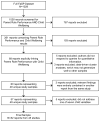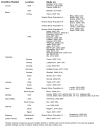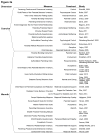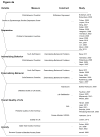Parenting behaviors and the well-being of children with a chronic physical condition
- PMID: 29172624
- PMCID: PMC5880719
- DOI: 10.1037/fsh0000305
Parenting behaviors and the well-being of children with a chronic physical condition
Abstract
Introduction: Numerous studies have identified the importance of parenting behaviors to the well-being of children with chronic physical conditions. Synthesizing the findings of these studies has potential to identify which parenting behaviors are associated with specific aspects of child well-being.
Method: We retrieved research reports addressing the relationship between parenting behaviors and well-being in children with chronic physical conditions, and categorized parenting behaviors based on Skinner, Johnson, and Snyder's (2005) core dimensions of parenting (warmth, rejection, structure, chaos, autonomy support, and coercion) Through meta-analysis, we examined relationships between parenting dimension and child well-being variables.
Results: Fifty-four reports from 47 unique studies met inclusion criteria. Parent warmth was associated with less child depression, better quality of life, better physical functioning, and fewer externalizing behavior problems. Parent rejection was associated with more child depression, internalizing/externalizing behavior problems, and poorer physical functioning. Parent structure was associated with better child physical functioning. Parent chaos was associated with poorer child physical functioning. Parent autonomy support was associated with better quality of life and fewer externalizing behavior problems. Parent coercion was associated with more child depression, poorer quality of life, poorer physical function, and more internalizing behavior problems.
Conclusion: The results identify multiple, potentially modifiable parenting dimensions associated with well-being in children with a chronic condition, which could be targeted in developing family-focused interventions. They also provide evidence that research using Skinner's core dimensions could lead to conceptualization and study of parenting behaviors in ways that would enable comparison of parenting in a variety of health and sociocultural contexts. (PsycINFO Database Record
(c) 2018 APA, all rights reserved).
Conflict of interest statement
No conflict of interest has been declared by the authors.
Figures






Similar articles
-
A Comparison of Parenting Dimensions Between Deaf and Hearing Children.Clin Nurs Res. 2016 Jun;25(3):342-54. doi: 10.1177/1054773815619133. Epub 2015 Nov 29. Clin Nurs Res. 2016. PMID: 26620870
-
Psychosocial functioning in children with neurodevelopmental disorders and externalizing behavior problems.Disabil Rehabil. 2015;37(4):345-54. doi: 10.3109/09638288.2014.919361. Epub 2014 May 19. Disabil Rehabil. 2015. PMID: 24840026
-
Do the parent-child relationship and parenting behaviors differ between families with a child with and without chronic illness? A meta-analysis.J Pediatr Psychol. 2013 Aug;38(7):708-21. doi: 10.1093/jpepsy/jst020. Epub 2013 May 9. J Pediatr Psychol. 2013. PMID: 23660152
-
Treatment of child externalizing behavior problems: a comprehensive review and meta-meta-analysis on effects of parent-based interventions on parental characteristics.Eur Child Adolesc Psychiatry. 2019 Aug;28(8):1025-1036. doi: 10.1007/s00787-018-1175-3. Epub 2018 Jun 8. Eur Child Adolesc Psychiatry. 2019. PMID: 29948228 Review.
-
The impact of children's internalizing and externalizing problems on parenting: Transactional processes and reciprocal change over time.Dev Psychopathol. 2015 Nov;27(4 Pt 1):969-86. doi: 10.1017/S0954579415000632. Dev Psychopathol. 2015. PMID: 26439057 Review.
Cited by
-
Concurrent and Longitudinal Associations among Parenting Style, Responsibility, and Adherence in Youth with Cystic Fibrosis.Child Health Care. 2020;49(2):153-167. doi: 10.1080/02739615.2019.1616295. Epub 2019 May 27. Child Health Care. 2020. PMID: 32742054 Free PMC article.
-
Parent childhood experiences, parenting strategies, and youth health-related outcomes in Hispanic families with unhealthy weight: An intergenerational study.Eat Behav. 2024 Apr;53:101870. doi: 10.1016/j.eatbeh.2024.101870. Epub 2024 Mar 6. Eat Behav. 2024. PMID: 38460202 Free PMC article.
-
The Role of Compassion and Mindfulness in Building Parental Resilience When Caring for Children With Chronic Conditions: A Conceptual Model.Front Psychol. 2019 Aug 5;10:1602. doi: 10.3389/fpsyg.2019.01602. eCollection 2019. Front Psychol. 2019. PMID: 31428005 Free PMC article.
-
The mediating effects of parenting style on the relationship between parental stress and behavioral problems in girls with precocious puberty in Korea: a cross-sectional study.BMC Pediatr. 2023 Jul 12;23(1):352. doi: 10.1186/s12887-023-04172-1. BMC Pediatr. 2023. PMID: 37438739 Free PMC article.
-
A cross -sectional study on the status and determinants of parenting among 12-36 months old children in rural Nagpur.J Family Med Prim Care. 2024 Oct;13(10):4652-4656. doi: 10.4103/jfmpc.jfmpc_524_24. Epub 2024 Oct 18. J Family Med Prim Care. 2024. PMID: 39629357 Free PMC article.
References
-
- Anderson BJ, Holmbeck G, Iannotti RJ, McKay SV, Lochrie A, Volkening L, et al. Dyadic measures of the parent-child relationship during the transition to adolescence and glycemic control in children with type 1 diabetes. Families, Systems, & Health. 2009;27(2):141–152. doi: 10.1037/a0015759. - DOI - PMC - PubMed
-
- Barakat LP, Daniel LC, Smith K, Renée Robinson M, Patterson CA. Parental problem-solving abilities and the association of sickle cell disease complications with health-related quality of life for school-age children. Journal of Clinical Psychology in Medical Settings. 2014;21(1):56–65. doi: 10.1007/s10880-013-9379-7. - DOI - PMC - PubMed
Publication types
MeSH terms
Grants and funding
LinkOut - more resources
Full Text Sources
Other Literature Sources
Medical
Miscellaneous

